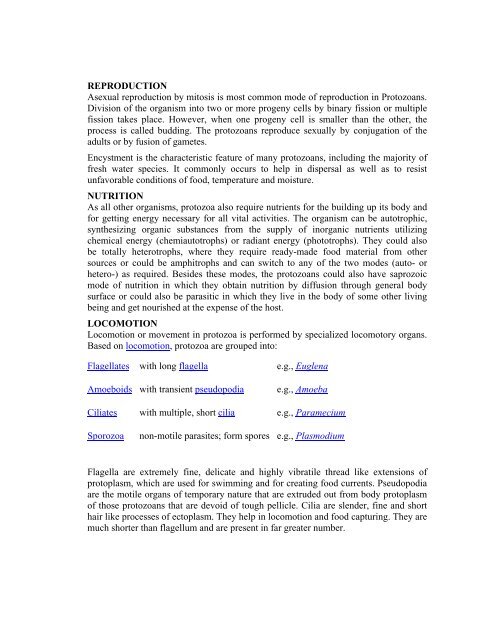ANIMAL DIVERSITY – I (NON-CHORDATES)
ANIMAL DIVERSITY – I (NON-CHORDATES)
ANIMAL DIVERSITY – I (NON-CHORDATES)
Create successful ePaper yourself
Turn your PDF publications into a flip-book with our unique Google optimized e-Paper software.
REPRODUCTION<br />
Asexual reproduction by mitosis is most common mode of reproduction in Protozoans.<br />
Division of the organism into two or more progeny cells by binary fission or multiple<br />
fission takes place. However, when one progeny cell is smaller than the other, the<br />
process is called budding. The protozoans reproduce sexually by conjugation of the<br />
adults or by fusion of gametes.<br />
Encystment is the characteristic feature of many protozoans, including the majority of<br />
fresh water species. It commonly occurs to help in dispersal as well as to resist<br />
unfavorable conditions of food, temperature and moisture.<br />
NUTRITION<br />
As all other organisms, protozoa also require nutrients for the building up its body and<br />
for getting energy necessary for all vital activities. The organism can be autotrophic,<br />
synthesizing organic substances from the supply of inorganic nutrients utilizing<br />
chemical energy (chemiautotrophs) or radiant energy (phototrophs). They could also<br />
be totally heterotrophs, where they require ready-made food material from other<br />
sources or could be amphitrophs and can switch to any of the two modes (auto- or<br />
hetero-) as required. Besides these modes, the protozoans could also have saprozoic<br />
mode of nutrition in which they obtain nutrition by diffusion through general body<br />
surface or could also be parasitic in which they live in the body of some other living<br />
being and get nourished at the expense of the host.<br />
LOCOMOTION<br />
Locomotion or movement in protozoa is performed by specialized locomotory organs.<br />
Based on locomotion, protozoa are grouped into:<br />
Flagellates with long flagella e.g., Euglena<br />
Amoeboids with transient pseudopodia e.g., Amoeba<br />
Ciliates with multiple, short cilia e.g., Paramecium<br />
Sporozoa non-motile parasites; form spores e.g., Plasmodium<br />
Flagella are extremely fine, delicate and highly vibratile thread like extensions of<br />
protoplasm, which are used for swimming and for creating food currents. Pseudopodia<br />
are the motile organs of temporary nature that are extruded out from body protoplasm<br />
of those protozoans that are devoid of tough pellicle. Cilia are slender, fine and short<br />
hair like processes of ectoplasm. They help in locomotion and food capturing. They are<br />
much shorter than flagellum and are present in far greater number.
















